Discovering the versatility of the mangosteen, the "queen of fruits"

Penang is widely acclaimed as a food paradise, renowned not only for its delectable street food and authentic Nyonya cuisine but also for its eclectic mix of foreign flavours. During fruit seasons, Penang is celebrated for its famous Balik Pulau durians as well as a variety of exotic tropical fruits including rambutans, mangosteens, cempedak (jackfruit) and langsat.

The mangosteen, hailed as the "queen of fruits", holds a popularity that rivals only the durian, known as the "king of fruits". While some may shy away from durians due to their pungent aroma, many find the mangosteen palatable and appealing. The contrast between the two is like the balance of yin and yang. Mangosteens are locally known for their "cooling" properties and are often enjoyed by the locals to counterbalance the "heatiness" associated with durians.
The roundish dark purplish-maroon fruit is about the size of a clementine, slightly flattened on the "bottom". It has a smooth, hard and thick rind encasing tender segments of soft opaque white flesh that is sweet with traces of floral tartness.

At the stem end, each fruit has four waxy sepals which form a crown-like shape. At the other, there are four to eight flat, woody lobes, arranged in a pretty rosette. Do you know that the number of those lobes corresponds to the number of fruit segments within? So if you find a mangosteen with eight lobes, you can expect to find eight segments of juicy flesh inside. Check it out and see if this is true the next time you enjoy some mangosteens.

To "open" a mangoesteen, most Penangites would squeeze the fruit between their palms with interlocking fingers. The rind of the fruit should yield under pressure and split. You can also use a knife. It is important to exercise caution when handling mangosteens as they can leave stains that are challenging to remove from clothings.
Tips for choosing the best fruits
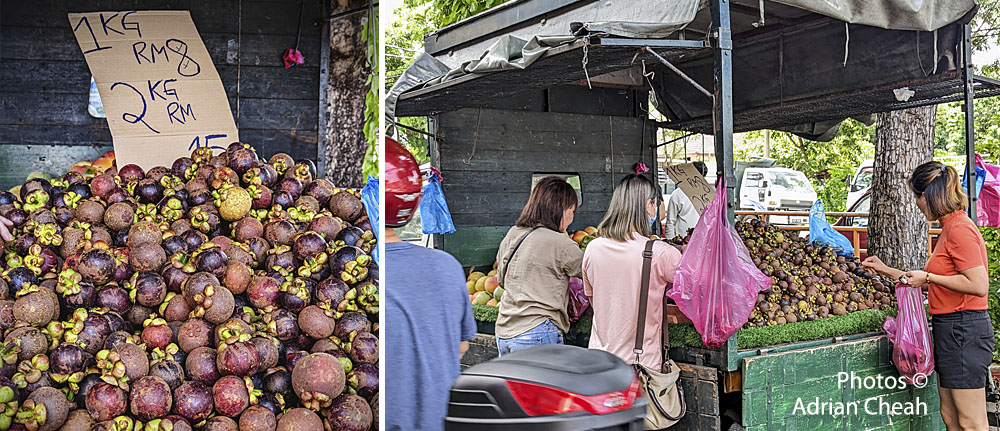

When buying mangosteens, choose larger fruits that feel heavy for their size. Generally, larger mangosteens tend to have more flesh and are often considered sweeter. Also go for fruits that have a darker shade of purple on the outer rind and bright green and glossy stems. Stems that are brown and hard indicate that the fruit is overripe. Avoid those that have cracks and bruises as these may be spoiled or past their prime. In Penang, if the fruit seller opens a mangosteen and encourages you to sample it, do indulge. Sampling allows you to experience the fruit's taste and quality firsthand before making a purchase decision.
The origins of the name "mangosteen"
The Tamil word "mangattān" or "mangakattān" is believed to be the origin of the Malay word "manggis," which later was adapted in English as "mangosteen".
Characteristics of the mangosteen tree
The mangosteen (Garcinia mangostana), native to Southeast Asia, is abundant in the region including Penang. The tropical climate is ideal for the trees as they require high humidity, abundant rainfall and well-drained soil. The fruit was first introduced to the Western world in the 18th century when naturalists and explorers encountered its tantalising taste.

Illustration: Garcinia mangostana L. from "Fleurs, Fruits et Feuillages Choisis de l'Ile de Java" (Selected Flowers, Fruit and Foliage from the Island of Java) by Berthe Hoola van Nooten (1817-1892), Pieter De Pannemaeker (lithographer).
According to britannica.com, "under favourable conditions, the slow-growing mangosteen tree can reach a height of 9.5 metres (31 feet). Seedlings take about eight to 15 years to bear fruit. Individual trees have been reported to yield more than 1,000 fruits in a season, but the plants usually produce good crops only in alternate years. It has thick, dark green, glossy leaves, 15–25 cm (6–10 inches) long, borne in opposite pairs along the stem, and large rose-pink flowers."
Since the mangosteen trees are notoriously slow-growing and take a considerable amount of time to start fruiting from seed, many trees grown for fruit production are propagated through grafting or budding, to ensure that the resulting tree will bear fruit within a shorter time frame.
From culinary delights to a diverse range of products
The mangosteen's unique flavour and properties have inspired its use in various culinary creations and a wide array of products.
The mangosteen's subtle yet distinct flavour has made it an uncommon ingredient in some culinary creations. In Thailand, the unripe mangosteen flesh is added in curries or preserved while ripe, seedless segments are tossed into salads. I have yet to come across any recipe in Penang that uses the mangosteen as a star ingredient. I am sure its sweet and tangy taste can complement both sweet and savoury dishes.

Canned mangosteens, preserved in light syrup, allow enjoyment of this fruit even during off-season periods. I have yet to sample this although I am sure enjoying the fresh fruits will be more rewarding. Freeze-dried mangosteen is another item that piques my interest and I look forward to sampling it.
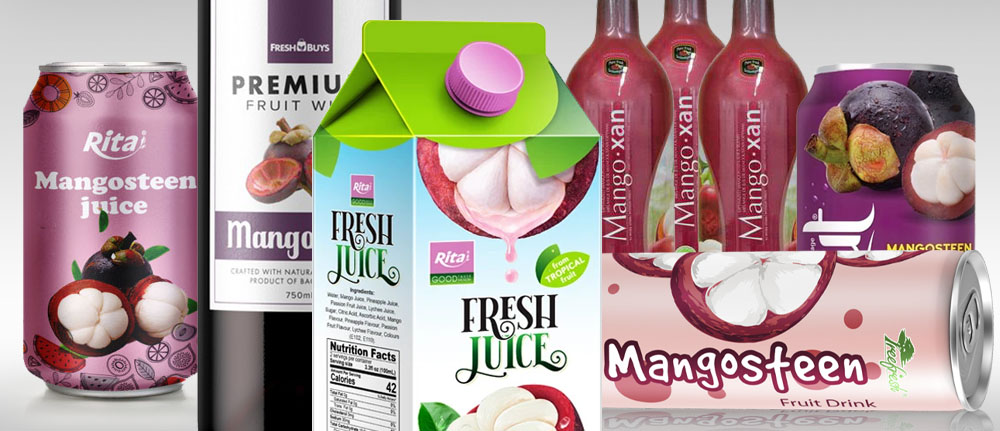
Canned mangosteen juice is now on the market as well as mangosteen tea and mangosteen powder (recommended for smoothies, juices or mixed into desserts, yogurt or ice cream). I have also added mangosteen wine and liqueur to my list of must-try items.

The mangosteen's remarkable properties have also led to its introduction into various industries including skincare, essential oils and health supplements. The mangosteen is increasingly used in skincare formulations due to its antioxidant and anti-inflammatory properties. Mangosteen essential oil is gaining popularity in aromatherapy and natural remedies, believed to possess antibacterial and antifungal properties. Mangosteen supplements, on the other hand, typically in the form of capsules, powders or juices, are often marketed for their potential antioxidant and immune-boosting properties. With the boom of such products, I feel that more scientific studies are needed to validate these claims.
Stamps and paintings with mangosteen
While the mangosteen may not be as prominently featured in famous art as some other fruits like apples or grapes, it has made appearances in certain artistic representations.

Over the years, Pos Malaysia has issued stamps featuring mangosteen. These stamps celebrate the country's rich agricultural heritage and highlight the diversity of local fruits, including mangosteen.
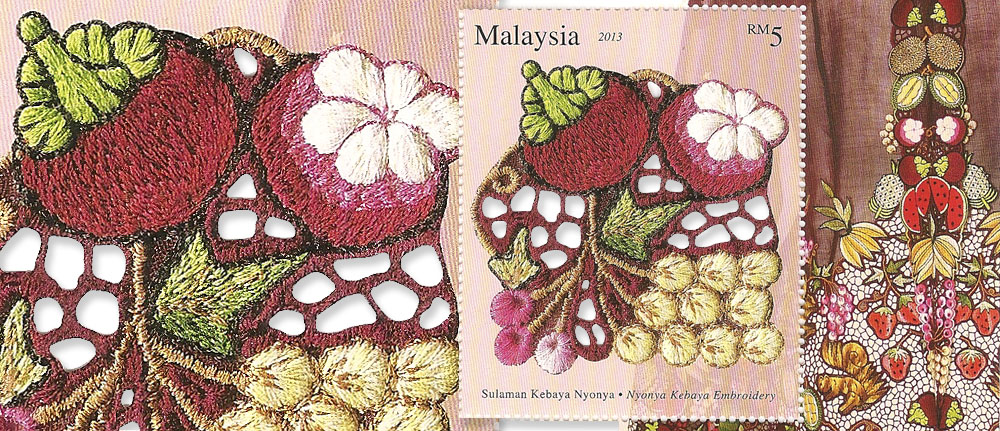
One of my favourite designs is the 2013 "The Baba & Nyonya Heritage" series. The RM5 stamp in this series depicts a Nyonya kebaya adorned with beautiful tropical fruits including mangosteen motifs. The incorporation of die cutting to mimic the "tebuk lubang" (literally to punch holes) in the intricate embroidery work adds an extra layer of detail and creativity to the stamp design. It is delightful when stamps capture cultural elements and celebrate the natural beauty and significance of fruits like the mangosteen.

The grande dame of Chinese Peranakan art, the late Sylvia Lee Goh (1940-2021), was a close friend of mine. As a self-taught artist, Sylvia’s works had always been a search for identity, reflecting her personal mark on bonding, relationships and her daily way of life. They showcased nostalgic memories and captured personal narratives of a culture that revelled in all things beautiful.
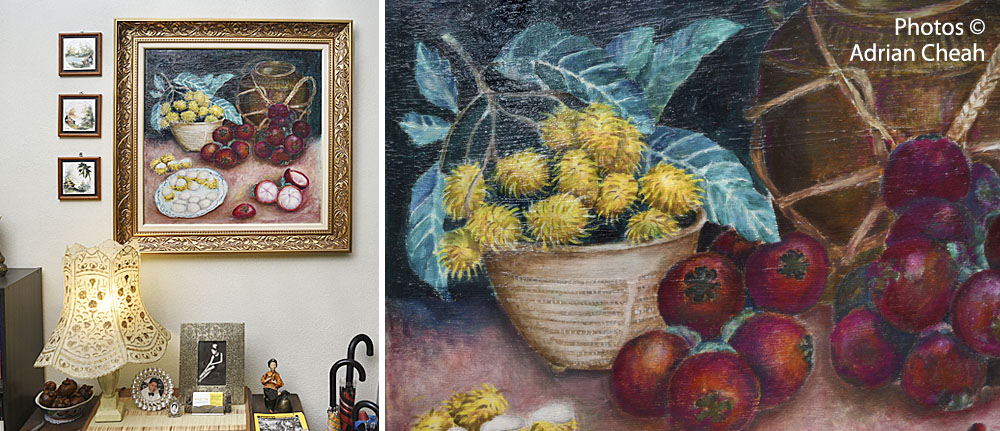
In her still-life masterpiece “Yellow bowl and rambutans”, she included some mangosteens. The painting showcases the artist's skill in capturing the natural beauty and detail of the fruit. This vibrant oil painting that I will cherish a lifetime over now hangs proudly in my office.
The mangosteen stands out as a true gem among fruits, offering a delightful blend of taste and health benefits. Writing this story has deepened my appreciation of the incredible versatility the "queen of fruits" offers.
-------------------------------------
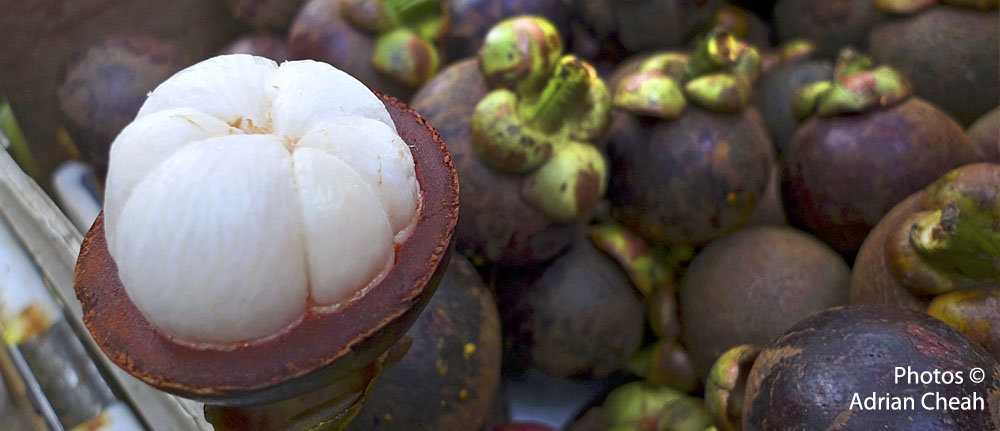
The mangosteen season in Penang typically occurs from May to August, with the peak season falling between June and July. At times, they also from November and January.
Fast facts: The mangosteen contains the following nutritional composition per 100 g of fruit: 0.41 g of protein, 17.91 g of carbohydrates, 1.8 g of total dietary fibre, 2.9 mg of vitamin C (www.sciencedirect.com).
Please note that these values are approximate and can vary slightly depending on the variety and ripeness of the fruit.
-------------------------------------
Written and photographed by Adrian Cheah
© All rights reserved
2 June 2023